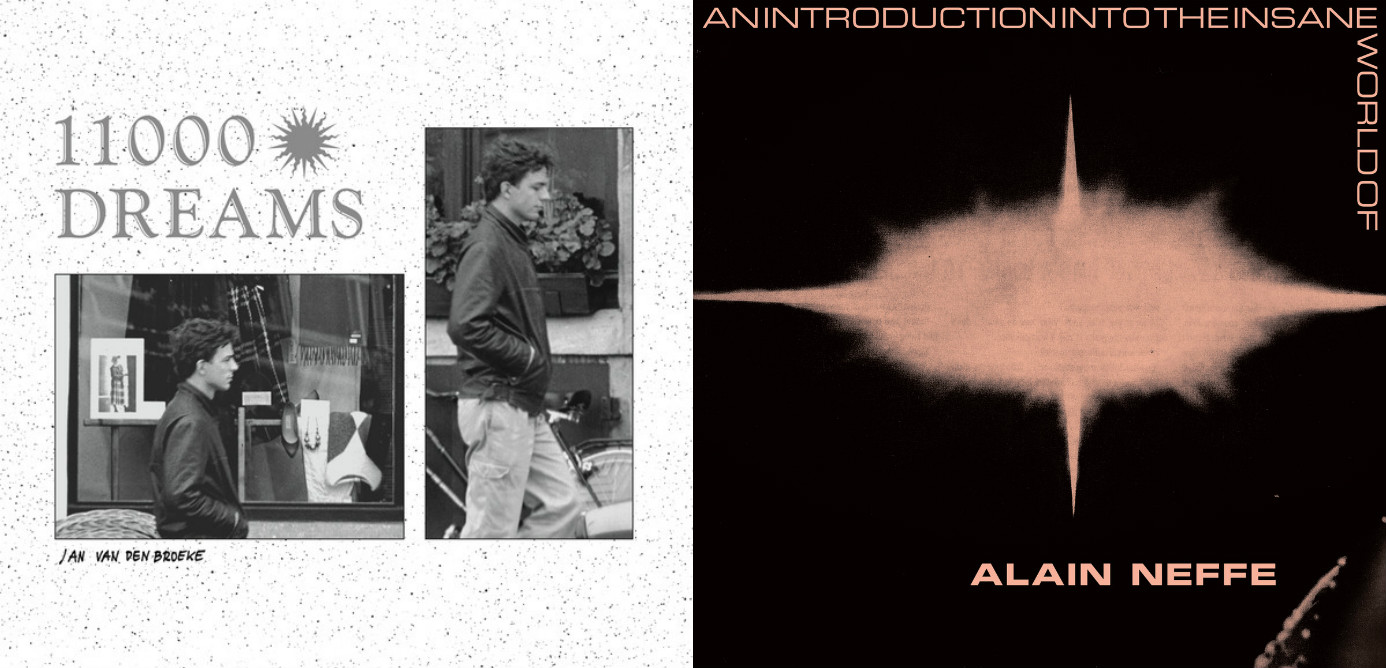The Insane World Of Alain Neffe & The 11,000 Dreams Of Jan Van Der Broecke

In many ways, a map of Europe delineates the rarefied developments in pop culture as much as terrain, territory and history. In the electronic music of the 1980s, as DIY methods of music making and distribution proliferated – after punk opened the floodgates – each country, and the regions and cities within them, responded in their own way. The reaction wasn’t just limited to Europe either. Countless nuanced denominations and subcells of post-punk, new wave and electronic music developed as a result of accessible means and creative audacity. It’s a contextual sketch that bears repeating but probably isn’t news to anyone, at least anyone who has taken a passing interest in archival records and the specialist labels that have released them over the last couple of years. It can often feel that every corner of the 80s has been or is in the process of being exhumed, for better (the novelty, the discovery, the re-evaluation) or worse (the nostalgia, the anxiety of influence, the overreliance on a bygone era).
For instance, in the last few months, some of the worthier missives of this regard have included an extensive Din A Testbild retrospective helmed by Mannequin and a Kas Product collection overseen by Sounds of The Universe. But where the former has affiliations with Germany and Neue Deutsche Welle and the latter with France and the Coldwave scene, two separate recent curiosities brought together by the Belgian label and ‘audiovisual center’ Stroom.tv add an interesting sense of divergence into the context of European electronic music and even further afield. Instead of representing an acquiescent addition to the consensus, both Alain Neffe and Jan Van Der Broecke’s work displays idiosyncratic qualities which are often underplayed, undervalued or completely absent in 80s electronic music, or at least how that music has been contextualized and appreciated in the contemporary era. You’d be forgiven for thinking that every project conceived at the time was defined by dystopian futurism and hardcore provocation, the sleek kineticism and bristling siege often found in what we now retrospectively assign as industrial and wave based music. Whilst the work collected on each compilation comprises moments which share some concordance with these models, each one feels very much like the product of an individual unwilling to concede to what was expected or to what others were doing. They also add fuel to the argument that Belgium – pre-New Beat – had a vibrant and disparate scene just as worthy of celebration as anything emerging out of Germany, France, Italy or anywhere else.
Although the name Alain Neffe may not have much significant traction the music he released on his cult label Insane Music, most notably realised on his cassette series ‘Insane Music for Insane People’ (including Merzbow, Jarboe, Tara Cross, Algebra Suicide amongst many others) undoubtedly merits recognition, not only for the adventurous nature of the work selected but for the prolific run of releases the label managed to notch up. The fruits of his own myriad projects, collated here, run a broad gamut, from the transfixing minimalist deliberation of his Pseudo Code alias – where the machines seem to be playing by their own volition, locked in some eternal recurrence – to the fleet-footed askew synth pop of Subject’s ‘Be Careful!’ and the bold DIY disco of Bene Gesserit’s ‘Tonight’. Of course there are many departures beyond these brackets. The introduction, for one, is a sepulchral induction into what sounds like a heathen drum circle, some grim sacrificial procession which approaches a kind of modernized inflection on the marginal sidereal psychedelia of The Legendary Pink Dots (who Neffe also released) and Vox Populi. Yet with the succeeding spryness of ‘Nobody Knows’ Neffe deviates completely, suggesting he didn’t stay in one place for too long. The mournful reductionism and Oriental tinge of Human Flesh’s ‘One Way Conversation Part I’, the surrendered repose of BG’s ‘On Protège Bien Les Requins’ and the rudimental Carpenter-esque prowl of ‘Every Ill Man’ (a track with an unforgettable vocal supplied by Debbie Jaffe of Master/Slave Relationship) only reinforces the sense of a low-key figure doing what he pleased, often with extraordinary results. Together ‘The Insane World…’ comes off like a self-portrait, but instead of a stable shot of a single profile, a multitude of personas floods the frame. It’s compelling to hear them all jostling around.
Where there is a severe, heady and discursive quality to Neffe’s ‘Insane World’, the one projected by Jan Van Der Broecke remains reclusive even as it reveals itself, a music content to swirl in the air or to diffidently motor along, heightened by poignant poetics. June 11 – the most contemporary of Broecke’s projects – opens proceedings like a dream beamed in from some halcyonic seventh heaven, a blinding conveyance of warmth and light narrated by a lone enraptured voice. As with Neffe, a different pseudonym signals a logical sense of transition. Whilst June 11 emits resplendence, Broecke’s work as Absent Music is sheer and phantasmal, channelling a crestfallen sense of desertion on ‘Akahito’. Sharing its namesake with an ancient Japanese poet, it’s subtly imbued with the kind of lonely dustbowl sustain found on Ry Cooder’s soundtrack for Wim Wenders ‘Paris, Texas’, if alloyed with the bedsit expressionism of The Durutti Column and the lissom modernity of Anna Domino’s early work. Elsewhere ‘My Lesbian Girlfriends’ continues in that vein, though trades the solemnity for crooked contemplation, and on ‘The Monkey House’, Broecke substitutes sparse blues and strange humour for an understated, cyclical concoction of nonsensical bliss. Together these works have the resemblance of something too intimate and too singular to be neatly aligned with Minimal Wave or indeed any closely affiliated banner, the mark of an individualistic response rather than unanimous conformity.
At the same time Broecke was engaged in the Absent Music project, he was collaborating with Dries Dekocker as The Misz, who also feature here. Detailing the context in which they were making music, Broecke’s notes on the project indicate where they were coming from at the time and suggests that the introversion that pervades his work wasn’t merely an escapist reflex, more of a desire to create in uncertain circumstances: ‘We were in our twenties, we had little money. The world was filled with disasters. The time coloured black.’ With the way things currently lie, this could just as well apply to any contemporary creative endeavour and might explain why his work – not only as The Misz but under other pseudonyms – maintains an enduring resonance; the context that informed and drove the compulsion, a situation that’s probably familiar to many of us. The inauspiciousness and limitations inherent in his approach has given these tracks a natural, unforced quality, a preserved purity, without the contrivance of expectation or premeditation. There lies the charm.
If Broecke perceived a black, desolate quality to the time in which he was producing work as Absent Music and The Misz, June 11 is a late period florescence, the sound of sunlight finally pouring in. Comprising the concluding half of the compilation – in addition to that dream sequence intro – it’s a project that reaches for aerial calm after the minimalist angst of his prior projects. Dipping its toes into the dubious planes of ‘new age’ and ‘world’ music without falling victim to formulaic appropriation, it’s more in keeping with what you might find on a new RVNG Intl missive or a Music from Memory compilation. Still, Broecke probably put it best by defining the project as one motivated by a longing to ‘dissolve in the moment’.
That desire, to allow their intuition to completely dictate the music, to create without calculation, is probably the key to both Neffe and Broecke’s appeal. They both appear to indulge conflicting impulses. Pop frivolity as much as monochromatic minimalism and immersive soundscapes. With all of this brought into proximity it suggests this all just spilled out of them, without much forethought. That’s probably why you’ve got one guy predisposed to playing with the ‘insane’, going from ritualistic synth-psych to rickety dodgy disco immediacy, and one inspired by Japanese poets, monkeys and making music that almost seems to be in a process of beguiling dissipation.






















